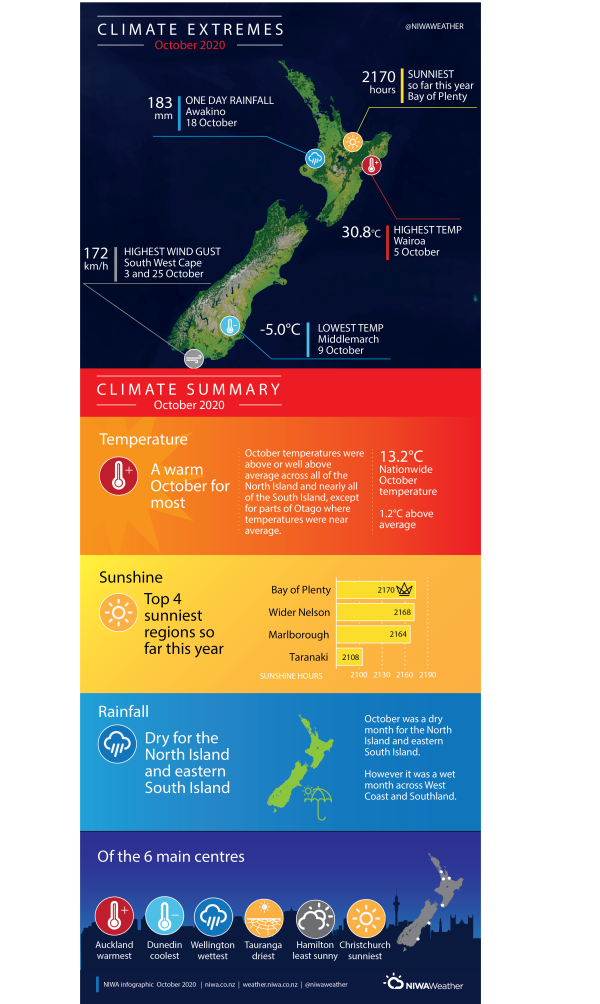A warm and dry month for much of New Zealand.
|
Rainfall |
Rainfall was well below normal (<50% of normal) for parts of Northland, much of Auckland, northern Waikato, Bay of Plenty, much of Gisborne, Wairarapa, Marlborough, and central Canterbury. Below normal rainfall (50-79% of normal) was observed in nearly all remaining portions of the North Island, as well as Nelson, northern Canterbury, and interior central Canterbury in the South Island. Conversely, above normal (120-149% of normal) rainfall was widespread across the West Coast, Fiordland, much of Southland, and Stewart Island. |
|
Temperature |
Temperatures were above average (0.51°C to 1.2°C above average) or well above average (>1.2°C above average) across all of the North Island and nearly all of the South Island, except for parts of eastern Otago where temperatures were near average (±0.50°C of average). |
|
Soil Moisture |
As of 1 November, soil moisture was lower than normal across approximately the northern third of the North Island, Wairarapa, Marlborough, and central Canterbury south to eastern Otago. Soil moisture was considerably lower than normal in coastal Bay of Plenty, East Cape, Wairarapa, and central Canterbury – these areas were categorised as “Dry” or “Very Dry” according to NIWA’s New Zealand Drought Index. Soil moisture was higher than normal in interior Manawatu-Whanganui, northern Tasman, and Southland. Soil moisture was generally near normal for remaining areas of New Zealand. |
Overview
October 2020 was characterised by higher than normal mean sea level pressure over and to the east of the North Island. This pressure set up resulted in a north to northeast wind flow anomaly across the country (i.e. more north to northeast winds than normal). However, at times westerly winds also affected the South Island. Overall, this was consistent with a developing La Niña in the equatorial Pacific. The prevalence of high pressure resulted in a dry month across the North Island and upper South Island, where rainfall was below normal (50-79% of normal) or well below normal (<50% of normal). In fact, Auckland (Western Springs) had its driest October since records began in 1948, with only 20% of its normal October rainfall. Conversely, periodic westerly winds brought several moisture-rich fronts to the west and south of the South Island, resulting in widespread above normal (120-149% of normal) rainfall for the West Coast, Southland, and Stewart Island. However, these westerly winds descending off the eastern slopes of the Southern Alps caused a very dry month across central Canterbury, where below to well below rainfall was widespread.
High pressure and northerly-quarter winds were an ideal recipe for warm temperatures, resulting in above average (0.51°C to 1.20°C above average) to well above average (>1.20°C above average) temperatures across all of the North Island and nearly all of the South Island. Notably, Te Puke experienced its warmest October since records began there in 1973, while Tauranga had its second-warmest October since 1913. Overall, the nationwide average temperature in October 2020 was 13.2°C. This was 1.2°C above the 1981-2010 October average, making it New Zealand’s 5th-warmest October since NIWA’s seven station temperature series began in 1909, and the warmest October since 2001. It has now been 45 consecutive months since New Zealand’s nationwide average temperature was below average.
Further highlights
- The highest temperature was 30.8°C, observed at Wairoa on 5 October.
- The lowest temperature was -5.0°C, observed at Middlemarch on 9 October.
- The highest 1-day rainfall was 183 mm, recorded at Awakino on 18 October.
- The highest wind gust was 172 km/h, observed at South West Cape on 3 and 25 October.
- Of the six main centres in October 2020, Auckland was the warmest, Dunedin was the coolest, Wellington was the wettest, Tauranga was the driest, Christchurch was the sunniest, and Hamilton was the least sunny.
- Of the available, regularly reporting sunshine observation sites, the sunniest four regions in 2020 so far are Bay of Plenty (2170 hours), Wider Nelson (2168 hours), Marlborough (2164 hours) and Taranaki (2108 hours).
Download
- New Zealand Climate Summary: October 2020 [PDF 965KB]
- Climate Statistics - October 2020 [PDF 63.17 KB]
New Zealand Climate Summary: October 2020


